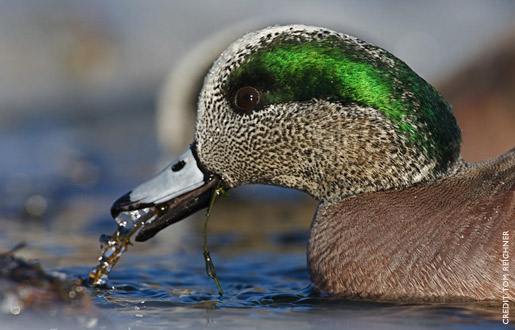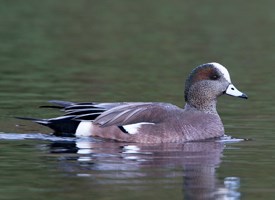
Anas americana
SUBFAMILY
Anatinae
TAXONOMY
Anas americana Gmelin, 1789, Lousinana and New York.
Monotypic.
OTHER COMMON NAMES
English: Baldpate; French: Canard d’Amйrique; German:
Nordamerikanische Pfeifente; Spanish: Silbуn Americano.
PHYSICAL CHARACTERISTICS
17.7–22.1 in (45–56 cm); 1.5–1.7 lb (680–770 g). Male has dark
green band along side of head.
DISTRIBUTION
Western and Central North America; some populations breed
from New Brunswick south to Massachusets. Winter from
Alaska south to Central America, Gulf and Atlantic coasts.
HABITAT
Shallow lakes and open wetlands surrounded by meadows or
agricultural lands; during winter mostly in coastal wetlands.
BEHAVIOR
Territorial during the early breeding season. Paired males
swim ‘in tandem’ with lone intruding males. Migratory.
FEEDING ECOLOGY AND DIET
Vegetarian, feeds by walking, wading, or swimming in shallow
water.
REPRODUCTIVE BIOLOGY
Seasonally monogamous until midincubation. Breeding begins
Apr.–May. Lays 4–8 eggs into a concealed shallow depression;
incubation 23–25 days; fledging c. 37–48 days. Becomes sexually
mature at 1–2; years.
CONSERVATION STATUS
Not threatened. Locally abundant. Critical habitats protected.
SIGNIFICANCE TO HUMANS
Hunted for sport and food.
Photo Gallery of - American wigeon




 Animalia Life
Animalia Life